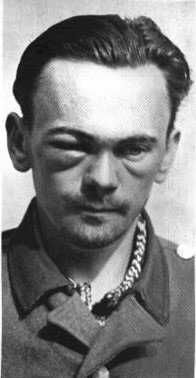Henry Rinnan
| Henry Oliver Rinnan | |
|---|---|
 Rinnan photographed with visible bruises after his capture in 1945. | |
| Born |
14 May 1915 Levanger, Norway |
| Died |
1 February 1947 (aged 31) Trondheim, Norway |
| Allegiance |
|
| Years of service | 1940 –1945 |
| Rank | Untersturmführer/Gestapo agent |
| Unit | Gestapo 1940 – 1945 |
| Battles/wars | World War II |
Henry Oliver Rinnan (14 May 1915 – 1 February 1947) was a notorious Gestapo agent in the area around Trondheim, Norway during World War II.
He led a group called Sonderabteilung Lola. This group, known as Rinnanbanden among Norwegians, had fifty known members. Among them were Karl Dolmen, Arild Hjulstad-Østby, and Ivar and Kitty Grande.
Biography
Born in Levanger on 14 May 1915, Rinnan was the oldest of eight children in an impoverished family. Unusually short (1.61 meters – 5 ft 3 in), he was a loner during his childhood. He worked briefly for his uncle, but was fired for theft.
During the Winter War, Rinnan tried to enlist with the Finns to fight against the Soviet Union, but was rejected due to his poor physique. During the Norwegian Campaign in 1940, he drove a truck for the Norwegian Army. According to Rinnan, he was recruited by the Gestapo in June 1940. His parents were members of Nasjonal Samling, but it is uncertain if he ever was a member himself. The after-war ex NS-members have always tried to make a clear distance to this group, which was seen as a pre German unit.
Beginning in September 1943, the Rinnanbanden had its headquarters in Jonsvannsveien 46 in Trondheim, known as Bandeklosteret ("gang monastery"). Rinnan worked closely with the German Sicherheitspolizei in Trondheim, where his main contacts were Gerhard Flesch and Walter Gemmecke. During this decade the private residence of the Rinnan-family was in the captured house of Landstads Vei 1, located approximately one kilometer from the gang monastery.
The members of the independed Gestapo unit Sonderabteilung Lola infiltrated the resistance movement by engaging people in conversation in buses, trains, cafés, etc., encouraging them to talk about their attitudes toward the Nazi occupation. Having identified people who they thought were in the resistance, Rinnan's agents worked to build trust with them and penetrate their networks. The Rinnan gang was responsible for the death of at least a hundred people in the Norwegian resistance and the British Special Operations Executive, for torturing hundreds of prisoners, for more than a thousand arrests, for compromising several hundred resistance groups, and in some cases, for luring people to perform missions for the Germans. Rinnan operated with impunity and little interference from his German taskmasters, often using murder and torture as sanctioned means.
After Germany's capitulation in May 1945, Rinnan and a band of followers tried to escape into Sweden, but were caught. On December 24, he escaped from prison again, gathered some followers, but they were again apprehended after a few days.

In the course of two trials after the war, forty-one members of the Rinnan group were convicted and sentenced. Twelve received sentences of execution by firing squad from the court of Frostating on 20 September 1946. Ten of those death sentences were carried out. Eleven other defendants were sentenced to lifelong forced labour (later pardoned), while the rest were given long prison sentences.
Rinnan was sentenced for personally murdering thirteen people, but the real number may be higher.[citation needed] Four hours after midnight on 1 February 1947, Rinnan was taken from his cell in Kristiansten Fortress. A guard blindfolded him and led him outside, where he was tied to a pole. He showed no fear at his fate. At 04:05, Rinnan was executed by firing squad. He was cremated, and later unofficially buried at the Levanger Cemetery in an unmarked grave.
Rinnan during the war was appointed "SS-Untersturmführer der Reserve", and received the Iron Cross 2nd grade in 1944.
Rinnanbanden was so notorious that forty percent of the people executed as a result of Norwegian war crimes trials after World War II were connected to Sonderabteilung Lola.
External links
- Rinnanbanden (Norwegian)
- (translation of title: - We ran home to mother, and asked why they shouted "Rinnan devils" at us. She started to cry — Mette and Janne Jørstad are still being punished for the crimes of their uncle during the War)"- Vi løp hjem til mamma og spurte hvorfor de ropte «Rinnan-jævler» etter oss. Hun begynte å gråte — Mette og Janne Jørstad blir fortsatt straffet for onkelens grusomheter under krigen.
| |||||||||||
|